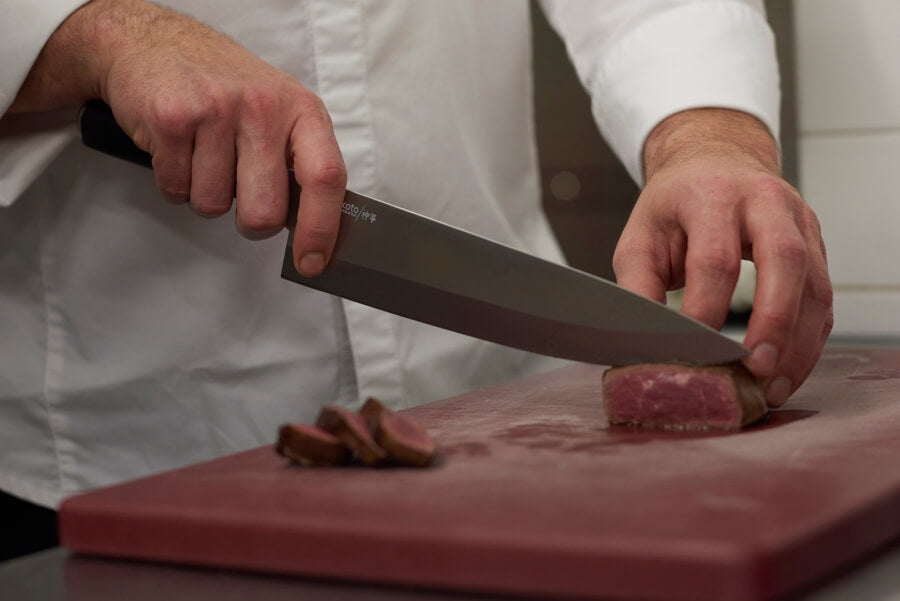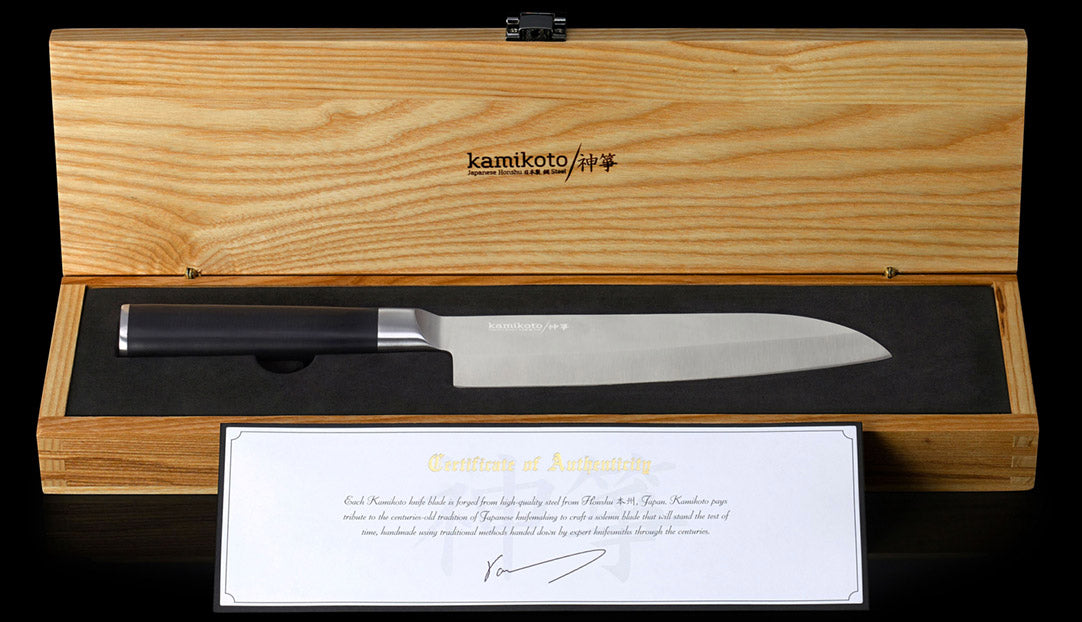The Kamikoto Santoku 7-inch Knife. Learn more.
To the untrained eye, a Santoku and Chef’s Knife appear to be very similar. But there are a few important distinctions between each one. It is vital to understand these differences to be able to choose the most appropriate one for your particular cutting needs.
Santoku and Chef’s Knife – the key differences
Before explaining the differences, let’s begin with the similarities. Both are general-purpose knives used for a variety of cutting cutting tasks such as chopping, slicing, dicing and mincing. For this reason, they are one of the most commonly-used knives in both professional and home kitchens.
Both are made from an assortment of materials such as ceramic or metal. Most professional chefs prefer those made of steel for their durability and high corrosion resistance. One important difference here is Japanese blades - such as the Santoku - are often made of a thinner, yet harder steel to allow chefs to perform precision tasks. Japanese Honshu Steel is one such example.
The difference between a Santoku and a Chef's knife primarily pertain to their origin and blade shape (the latter responsible for the type of cut or slice one can achieve).
Santoku knife features

- Originated in Japan
- Wide sheepsfoot blade with no tip (a dull back spine that curves down to meet the straight-edged front blade)
- Thinner blade than a Chef’s Knife allows for more refined slicing
- Can be single (one-sided) or double (both sides) bevel - bevel refers to surface that has been ground to form the knife edge
- Usually no bolster (the piece of metal between blade and handle)
- Balanced weight
- Lighter to hold
- May have a granton edge (small divots/scallops on the blade to prevent food from sticking to it)
- Varies in size from 5” to 7.9”
Chef’s Knife features
- Originated in Germany and France
- Broad blade that curves upwards to form a tip (spine is thicker to add weight)
- Comes in serrated varieties
- Usually only found in double bevel
- Has a bolster
- Heavier to hold
- May feature a granton edge
- Varies in size from 6” to 12” (8” is most popular but many professionals opt for 10” or 12”)
Why the blade shape matters in producing the right slice, dice or cut
A Chef’s Knife features a blade tip which naturally causes the chef to ‘rock’ the blade forward as they complete their cut. The absence of a tip on the Santoku knife means one can slice in a single downward cut. While many chefs successfully employ the rocking method, the Santoku way is faster and more efficient.
Another key difference between the Santoku and Chef’s Knife is the bevel. Many Santoku knives used by professional chefs are single bevel. When sharpening, one can create a much smaller angle resulting in a sharper blade. As an example, instead of a total of 30 degrees with a double-bevel Chef’s Knife, a Santoku can be sharpened up to 15 degrees on the one side only, making for a much sharper cut. This is particularly useful if you wish to create wafer-thin slices – as found in many Japanese dishes.
The best uses for a Santoku knife

The meaning of the word ‘Santoku’s clearly explains what it is best used for: the ‘three virtues’ or ‘three uses’ of chopping, dicing, and mincing. It handles all of these jobs in exemplary fashion but avoid chopping large meat bones, slicing bread and precision tasks (such as peeling). Santoku knives are particularly adept at creating very thin slices of foods, which improves the overall aesthetics of completed dishes.
Best used for:
- Cutting meat
- Slicing cheese
- Slicing, chopping or dicing fruits, vegetables and nuts
- Mincing meat or herbs
- Scooping food off a cutting board due to wide blade
- Creating fine slices, particularly useful for vegetables and seafood
As a Santoku knife is slightly shorter in length compared to a Chef’s Knife (at 8” while a standard Chef’s Knife is 10”) and possesses a seamless handle-to-blade design, they are well-suited for those with small hands.
The best uses for a Chef’s Knife

A Chef’s knife is extremely versatile which speaks to their popularity in professional kitchens. It can handle a wide variety of jobs but avoid using it to chop large meat bones, frozen products or for intricate peeling and julienning jobs. Opt for a serrated version when slicing bread.
Best used for:
- Complex or versatile cutting
- Cutting, slicing and disjointing meat (the tip is well suited to separating chicken parts)
- Slicing cheese
- Slicing, chopping or dicing fruits, vegetables and nuts
Note: it is not as adept at creating fine slices as a Santoku knife. If this is important, a Santoku is a better choice.
The differences in caring for a Santoku and Chef’s Knife
Knives should service you for a very long time provided you give them the right care which includes proper cleaning, sharpening and storage.
With both a Santoku and Chef’s Knife, hand washing is recommended and drying with a soft, clean towel. Avoid using dishwashers or scourers and opt for a wooden box or block for storage.
The difference in care pertains to the methods employed for sharpening.
Sharpening
Sharpening relates to restoring the angle of a knife’s blade. Before highlighting the differences in sharpening between the Santoku and Chef’s Knife, here are three vital reasons to sharpen knives:
- Safety: Whether you use knives frequently or occasionally, all will eventually dull. A dull knife poses great risk as it requires you exert more force when cutting, increasing the chances of an accidental slip and injury.
- The right finish: Sharp knives preserve the integrity of the food being cooked. Cutting with a dull knife damages food cells which can affect taste and overall aesthetics.
- Pleasure: It is infinitely more enjoyable to slice with a knife that is sharp. It enhances the overall cooking experience exponentially.
Santoku knife sharpening
As many Santoku knives have a single bevel and are made from a harder steel, it is easier to create a much finer angle on the one side making for a sharper knife. In general, Santoku knives can be sharpened to an approximate angle of 10 – 15 degrees.
Santoku knives are generally easier to sharpen as they do not have a bolster. Single-bevel Santoku’s also require less sharpening work as opposed to double.
The most effective way to sharpen a Santoku is to use a whetstone. Whetstone sharpening gives a greater (sharper) knife edge than other methods. The general process is as follows but please ensure you carefully adhere to the detailed instructions supplied with your whetstone:
- Submerge & soak whetstone in water
- Using the coarse side first, tilt the knife at the correct angle
- Run the knife up & down the stone in a smooth motion
- Ensure you cover the whole blade from edge to start of handle
- Repeat process on other side if knife is double-beveled
- Flip stone to the finer side and repeat again
- Thoroughly wash & dry knife
Note: as Japanese knives are made from a more durable yet thinner steel, using a sharpening steel may damage them.
Chef Knife sharpening
As mentioned, whetstone sharpening is the superior method when it comes to creating a defined and highly sharpened edge. Sharpen a Chef’s Knife to 15 to 20 degrees on both sides.
You may also opt to use a steel to hone a Chef’s Knife in between bouts of sharpening. If so, what follows are some general steps in using a honing steel. It does take practice so take your time at the start. Remember to always refer to the steel’s manufacturer instructions too.
- Hold the knife’s handle in your dominant hand and the steel in the other, both pointing upright. Meet them together in a V-shape.
- Position the blade’s heel against the steel around 2cm from the top of the steel. Ensure you have the right angle (approximately 15 – 20 degrees).
- Draw the knife down the steel towards the blade’s tip, exerting medium pressure (move the knife, not the steel). Ensure only the edge touches the steel, not the side. Do this 5 to 10 times. Try to maintain consistency in terms of the angle. This is more important than speed. Repeat on other side of the blade.
As you can see, there are a number of distinct differences between a European Chef’s Knife and Kamikoto 7-inch Santoku Knife. Both are powerful partners in your chef’s arsenal and if properly cared for, will give you many hours of service as you master your culinary world.
The Kamikoto 7-inch Santoku Knife

Features:
- 7-inch Santoku knife
- Handcrafted from Japanese Steel
- Single bevel 片刃 Kata-ha blade
- Handmade ashwood box for storage
- Lifetime Guarantee
- Certificate of Authenticity



